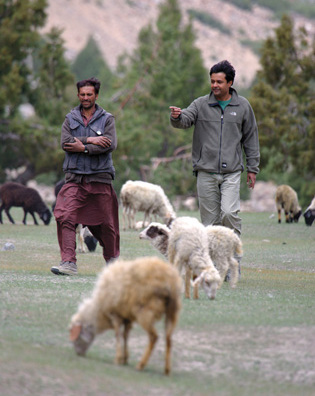 loading
loading
Where They Are NowHigh-altitude insurance Thierry Grobet/RolexShafqat Hussain ’02MEM, ’09PhD (right), visits a farmer in Pakistan, where Hussain devised an insurance plan against attacks on livestock by snow leopards. View full imageShafqat Hussain ’02MEM, ’09PhD, understands why people living in the Himalayan foothills kill the endangered snow leopard: snow leopards eat not only wild goats like the ibex and markhor, but also domestic goats and sheep. For the past decade, he has helped villagers in the remote Baltistan region of his native Pakistan set up communal funds to insure their livestock against snow leopard attack. For this innovative strategy, Hussain won a $50,000 Rolex Award for Enterprise in 2006. He will begin teaching at Trinity College in Hartford, Connecticut, this fall. Y: The villages where you work are in the Karakoram Range, which comprises huge peaks, including K2. You grew up in the lowlands, in Lahore. When did you first see the Himalayan foothills? H: In 1984. I was 15, traveling with my friend and his father. [I felt] awe and wonder. These are seriously big mountains. Y: After getting a bachelor's in economics, you went to Baltistan to work on a rural development project. Is that when you got interested in the tension between farming and snow leopard conservation? H: Yeah. That's why I went to work for the International Union for Conservation of Nature. The IUCN had a very orthodox approach -- that they should remove the people. If there are no people, then there are no depredations, and hence no retaliatory killings. Y: Were they actually trying to move people out of their villages? H: No, they were not, but this was the knee-jerk reaction: “Well, the people should get out of there.” Y: How did the idea of an insurance fund originate? H: I came to the U.S. to work with IUCN in the Washington office. There was a fellowship to groom young conservationists from the Third World. We were joking, and we said, “Well, we should provide insurance for these groups.” And then we started thinking, Hey, that might be actually possible. It made sense, because what you call the covariance of risk is very low. When agricultural crops fail, the likelihood is that the crops of the entire village will fail -- not just on one farm. But people own large numbers of goats and sheep, and they herd them together. A snow leopard usually takes one or two or three or four [animals]. Y: Why did you think an insurance program would work better than a prohibition on killing snow leopards? H: The premise is very simple and basic: people are not hostile to the snow leopard because they are backward; they have a legitimate concern. It is threatening their livelihood and security. Many studies have shown that a large percentage of the snow leopard's diet consists of domestic livestock. The snow leopard is biologically subsidized by poor farmers. So if we guarantee that they will be compensated for their losses, then we have basically eliminated their hostility. Y: How does the insurance work? H: Each farmer is required to pay a premium per head of livestock. For example, if their village has been losing 2 percent of the herd each year, then they set the insurance premium at 2 percent of the value of each animal. And there is a separate fund that matches the collective money that all the farmers have paid in. Y: Do the matching funds come from the Rolex Award? H: Yes, and from the Snow Leopard Conservancy in Seattle, and sometimes from individuals who have read about this. Y: When you visited Baltistan in April, did you hear any stories about how the fund has worked? H: One lady told us that there is a widow with four young children, and she had a flock of 18, and all of her animals were killed. Luckily she had insurance, and she was fully compensated, and she was so happy and surprised. And so are we. We are really happy. Y: Have you ever seen a snow leopard? H: No, I have not. I think you can easily see it in the region where we were, but you'd have to stay in a tent, 15,000 feet high, in mid-January, where the temperature is minus 45 degrees Celsius. Y: What kind of research are you doing? H: We are collecting snow leopard scat and doing diet studies and DNA analysis to look at the genetic variability of the snow leopard population in Pakistan. It tells us if there are genetic-flow bottlenecks, which means that the snow leopard population doesn't have genetic diversity. Then if the population is hit by a disease, the likelihood is that the entire population will be affected. For example, the cheetah population of southern Africa is having this problem. Many scientists claim it will go extinct in the next 50 years. Y: Is the snow leopard doing better or worse? H: There are no trends, because there is no baseline data against which you can measure any changes, but there have been a few reports recently which have been more optimistic. Y: Have you seen much social change in the villages of Baltistan? H: The democratization of communication which has occurred through cell phones is just phenomenal. And it is dirt cheap; everybody can afford it. It is very, very surreal. You see these people who have Nokia cell phones, and they are sitting at the top of the mountain talking.
The comment period has expired.
|
|